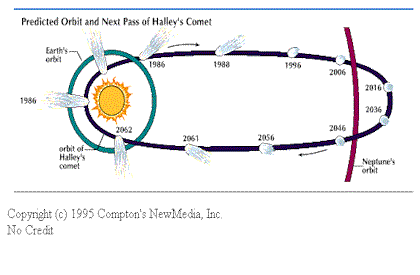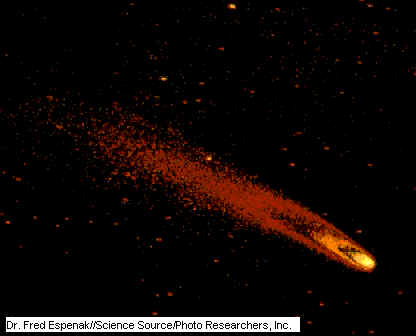

 COMET
COMET 
People now look forward with interest to sighting a comet,
but for many centuries comets were believed to have an evil influence on human affairs; in
particular, they were thought to foretell plagues, wars, and death. It was once thought
that comets were made of vapor and had risen from the Earth. It was not until the 17th
century that they began to be properly understood. In 1682 a comet appeared and was
observed by the astronomer Edmond Halley. He studied the written accounts of 24 comets
that had been seen from time to time since 1337 and calculated their orbits. He found that
the comets of 1531, 1607, and 1682 moved in almost the same paths, and he concluded they
were all the same one and that it would return in about 1758.
His forecast was correct, for the comet did appear in that
year, though Halley himself did not see it; he had died in 1742. For the first time
scientists realized that comets can be regular visitors, and the great comet was named
after Halley. It appeared in 1910, and in late 1982 it was spotted as a very faint dot,
close to its expected position, on its way to swing around the sun in 1986.
Structure and Composition
The nucleus, or core, of a comet resembles a large, dirty
snowball. It is thought to consist of about 25 percent dust and chunks of rocky or
metallic material and about 75 percent ice. The ice is mainly frozen water, with a mixture
of compounds containing methane, ammonia, and carbon dioxide radicals, or subunits of
molecules. Of the approximately 650 comets that have so far been scientifically recorded,
the largest has a nucleus measuring about 42 miles (68 kilometers) in diameter and the
smallest about 0.3 mile (0.5 kilometer). Smaller comets undoubtedly exist, but they do not
become bright enough to be detected by light telescopes. When a comet passes close to the
sun it loses some of its matter, usually about 0.3 percent of its mass per orbit. The
nuclei of comets are slightly less dense than water and are covered by a thin crust of
dust. They are fragile and have been observed breaking up into fragments.
As a comet nears the sun, its ice begins to sublimate that
is, to pass directly from a solid to a gas form. The gas carries with it some of the
loosely bound dust particles. The gases spread out around the nucleus, forming a large,
thin atmosphere called the coma. Sunlight causes the atoms in the coma to glow as a
pearly, spherical patch of light up to 62,000 miles (100,000 kilometers) in diameter. If
the supply of gases from the nucleus changes, a comet can brighten or fade unexpectedly,
so astronomers cannot predict how bright a comet will become.
As the comet approaches the sun the solar wind, which
consists of high-speed atomic nuclei, protons, and electrons, sweeps cometary gases away
from the sun, producing a straight tail of up to 93 million miles (150 million kilometers)
in length. A second tail consisting of dust particles may also appear. This dust tail is
shorter and more curved than the gas tail. Comet tails always point away from the sun
because of the force exerted by solar wind and radiation on the cometary material . When
comets travel away from the sun, therefore, their tail or tails are always in front of
them. Some comets have been observed to develop as many as nine tails.
Comets can be divided into two groups: short-period
comets, with orbital periods of less than 200 years, and long-period comets, with periods
on the order of millions of years. Short-period comets are members of the inner solar
system. When farthest away from the sun, long-period comets can be halfway to the nearest
stars. Comets can hit Earth; for example, the Tunguska explosion that occurred in 1908 in
central Siberia is thought to have resulted from such a collision.
Several theories for the origin of comets have been
proposed. According to one widely accepted view, comets are as old as the solar system and
are the remnants of the building blocks that produced Uranus and Neptune. They were tugged
out of their nearly circular orbits into extremely elongated orbits by the gravitational
fields of the outer planets, which were still forming. Hundreds of millions of comet
nuclei exist in a region called the Oort Cloud that surrounds the solar system like a
bubble. Such nuclei may travel out of the cloud when disturbed by the gravitational force
of a nearby star and enter the inner solar system .
On the average five new comets are discovered each year.
Most of these are faint and can only be observed with the aid of a telescope. The few
exceptionally bright comets seen from the Earth since the early years of the 20th century
include Halley's comet, Arend-Roland comet, and Ikeya-Seki comet.

Naming Comets
Many amateur astronomers watch the sky closely for new
comets. Newly discovered comets are first given a numerical designation made up of the
year of the discovery followed by a small letter showing the order of the discovery among
those of that year. For example, 1990e would be the fifth new comet spotted in the year
1990. Later, when the exact time of its reaching perihelion, or its closest approach to
the sun, has been determined, the numerical designation will be changed to a date followed
by a Roman numeral. If 1990e is the third comet to reach perihelion in 1991, it will
become known as 1991 III. At that time, it will also be officially named with the names of
up to three discoverers.

Image of a comet




![]()

